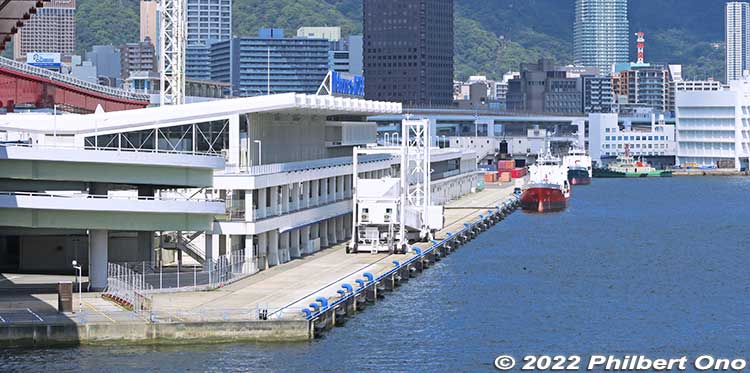
Historic port and Western Japan’s most popular cruise ship departure port.
by Philbert Ono, Updated: Feb. 3, 2023
Port of Kobe in Hyogo Prefecture (western Japan or Kansai Region) is one of Japan’s most historic ports and one of the two most popular departure ports for cruise ships. While Yokohama near Tokyo has historically been the main passenger ship terminal for eastern Japan, western Japan’s equivalent is Kobe, not far from Osaka. Kobe is also one of Japan’s five largest ports handling international cargo.
Cruise ships usually dock at Kobe Port Terminal aka Shinko Pier No. 4 (新港第四突堤) which has the Kobe Port Terminal building and Port Terminal Station on the Port Liner (Port Island Line) train line. It’s connected to the red Kobe Ohashi Bridge. Ships can dock on either side of the pier. To dock on the main or east side of the pier for immediate access to the terminal building, they must go around Kobe Airport since Kobe Ohashi Bridge is too low for most cruise ships.
Built in the 1920s, Kobe Port Terminal is Japan’s largest passenger ship pier with a length of 649 meters on the east side. With a water depth of 10 to 12 meters, it can dock mega-ships with a gross tonnage of 100,000+.
The three-story terminal building was built in April 1970 for international passenger ships. It was last renovated and made earthquake resistant in March 2015. The building has CIQ facilities, a lookout/sendoff deck or balcony, tourist information counter, waiting area, event hall, and Japan’s longest boarding bridge at 46 meters.
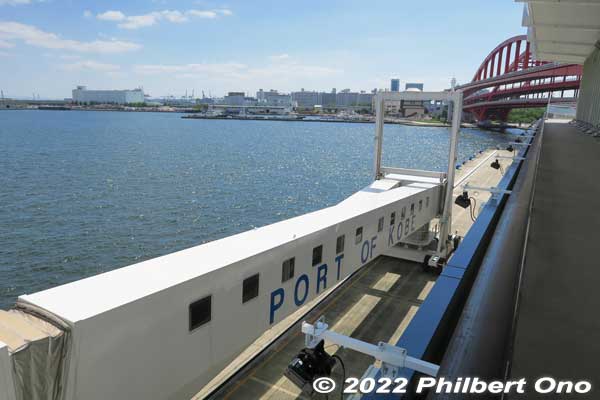
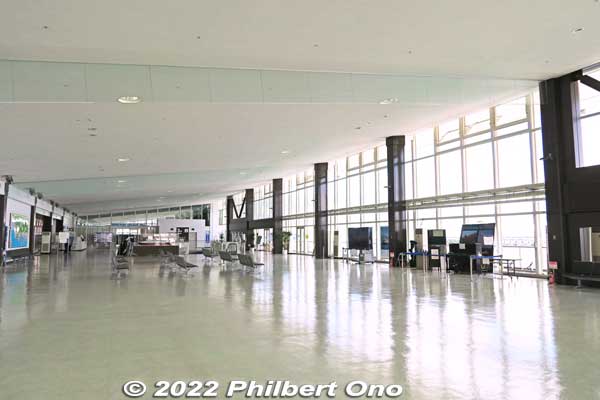
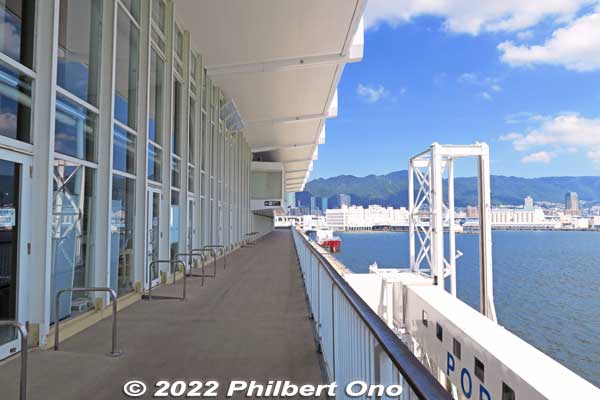
For cruise ships, welcome and sendoff ceremonies are usually held at the terminal building complete with a live band. Many mega-ships like the Queen Elizabeth have docked here since the 2010s.
The great thing about Kobe Port Terminal is Port Terminal Station right on the pier and right next to the terminal building. Super convenient for departing and arriving passengers and for any shore excursions. It’s on the Port Liner (Port Island Line) automated train line which goes to Sannomiya Station, Kobe’s main train station just minutes away.
The port also has shuttle buses going to Sannomiya Station and Motomachi. Sannomiya has many shops, restaurants, and train lines going on to Osaka, etc. Port Liner also goes to Port Island and Kobe Airport on the opposite end of the line.
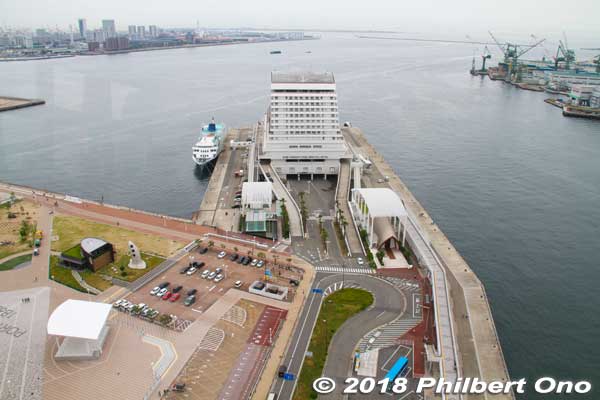
Since Jan. 2006 when a cruise ship terminal was built, Nakatottei Pier (Naka Pier Cruise Terminal) also started docking intermediate-size cruise ships at Meriken Park next to the wave-shaped Kobe Meriken Park Oriental Hotel. The hotel’s first and second floors serve as the cruise ship terminal with CIQ facilities. This pier is convenient for seeing Meriken Park and other sights (see list below).
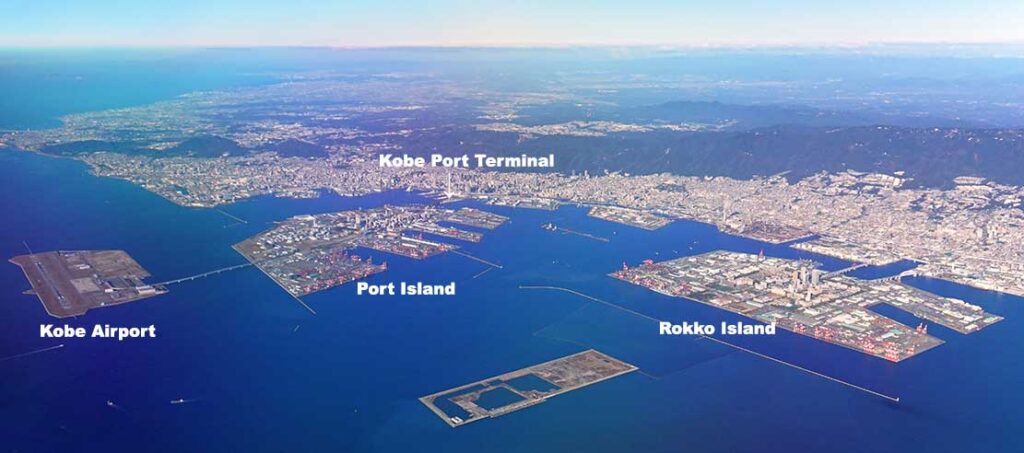
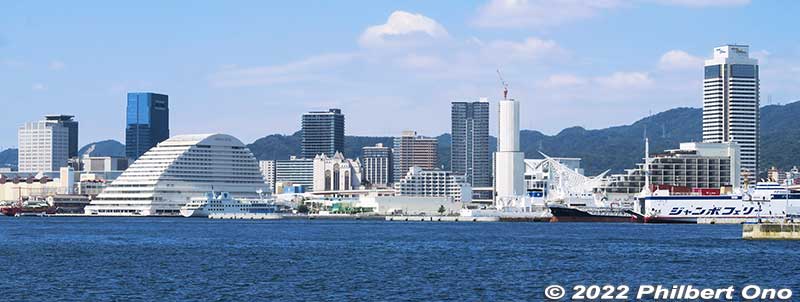
Kobe Port history
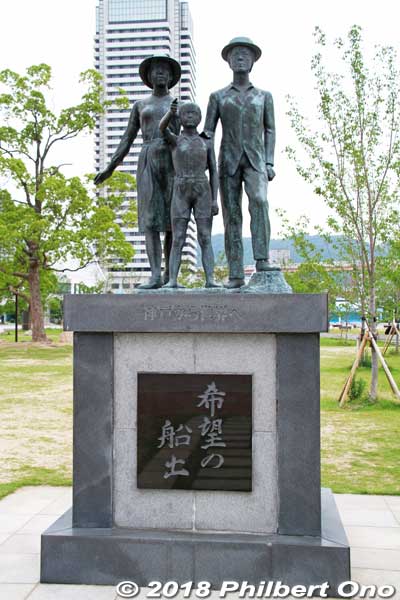
According to recorded history, Kobe Port had its beginnings in the 8th century as one of the five main ports in Seto Inland Sea. It was called Owada-no-tomari (大輪田泊). By the 12th to 13th centuries, the port was further developed as one of the main ports for trade with China. The port was called Hyogo-no-Tsu (兵庫津).
Toward the end of the Edo Period in 1864–1865, famous Military Commissioner and naval engineer Katsu Kaishū established the Kobe Naval Training Center (神戸海軍操練所) to train Japanese naval officers and develop Japan’s navy.
Kobe Port’s most historic development was its selection as one of Japan’s first treaty ports to open to international trade on January 1, 1868, after a five-year delay due to opposition by the Imperial court.
It was called “Hyogo Port” (兵庫港). As it developed into an international port, the name “Kobe Port” from nearby Kobe Village stuck. The port’s opening led to foreign settlers in Kobe whose Western-style homes and buildings still remain and now a major tourist attraction. Kobe soon grew into one of Asia’s largest ports.
Meriken Pier (Meriken Hatoba メリケン波止場) was soon built and functioned as the port’s main passenger pier for the foreign settlement. Since the U.S. Consulate was at the base of the pier, the pier came to be called “Meriken Pier.” “Meriken” is a misnomer for “American.”
Old photos of Meriken Pier can be found on many vintage postcards. It was Kobe Port’s main pier until the 1920s when it was superseded by the new Shinko Piers nearby. The location of the old U.S. Consulate is marked by a plaque on the Kobe Meriken Building (formerly named Kobe Yusen Building) now occupying that spot.
During World War II when America was the enemy, the pier was renamed “Bankoku Pier” (万国波止場).
Kobe Port was also one of the main ports for sending Japanese emigrants to South America. In April 1908, Kobe sent off the first ship of 781 Japanese emigrants to Brazil on the Kasato Maru (笠戸丸). Emigration to South America continued until 1941.

In 1928, the Kobe Emigration Center (神戸移住センター) opened for Japanese emigrants to stay for up to 10 days and receive orientation before voyaging to South America (mainly Brazil).
It closed in 1971 and it still exists as Japan’s only surviving building used for sending Japanese emigrants. It now houses an interesting emigrant museum and South American (mainly Brazilian) cultural exchange center named “Kobe Center for Overseas Migration and Cultural Interaction” (神戸市立海外移住と文化の交流センター). 15-min. walk from JR Motomachi Station.
In the early 1920s, Kobe Port was expanded with the construction of Shinko Piers No. 1 to 4. No. 3 is now a ferry terminal, and No. 4 eventually became Kobe Port Terminal for passenger ships.
During World War II, Kobe Port and other major Japanese ports were heavily attacked or bombed. After the war, Japan’s major ports came under the control of U.S. Occupation forces (GHQ) for military use. Even after the Occupation ended in 1951, parts of Kobe Port were still controlled by the U.S. for sending troops to the Korean War and Vietnam War. It wasn’t until 1974 when the Port of Kobe was fully returned to the city.
After World War II, emigration to South America restarted in 1952 with the Santos Maru sailing from Kobe to Brazil. Emigration ships waned by the mid-1960s when emigrants decreased and Japan’s high-growth economy spawned more jobs.
Japan’s last ship to transport emigrants to South America was the Nippon Maru, formerly Argentina Maru, leaving Yokohama in 1973 as part of a world cruise.
Like many other major Japanese ports, Port of Kobe was greatly expanded through land reclamation. Port Island near Kobe Port Terminal was completed in 1981, and Rokko Island was finished in 1992 after almost 20 years of construction. Besides having cargo ship berths, both artificial islands also have residential areas, schools, businesses, and their own public transportation system to central Kobe.
On January 17, 1995, the Port of Kobe got a major setback when the Great Hanshin Earthquake struck and killed over 6,000 residents and destroyed much of the port. Within several days though, at least one pier was reopened to enable volunteers and provisions to reach Kobe from Osaka port. Cruise ships also came to provide relief and accommodations.
Both Port Island and Rokko Island suffered liquefaction damage.
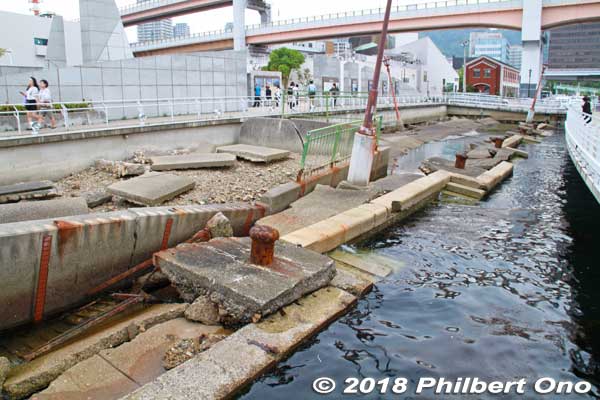
Kobe Port was soon rebuilt. In June 1995, an international cruise ship (Kareliya from Ukraine) arrived in Kobe for the first time since the quake and docked at Shinko Pier No. 1. Heavily damaged Kobe Port Terminal dedicated to cruise ships was also repaired and the Fuji Maru docked in July 1996.
Kobe Port was completely repaired two years after the quake. However, during the repair period, container transshipments were transferred to other Asian ports and Kobe never fully regained the loss of business as an international hub port.
Kobe Airport, built on an artificial island next to Port Island, opened in Feb. 2006.
Kobe Port’s sister ports include Seattle Port, Washington and Rotterdam Port, Holland.
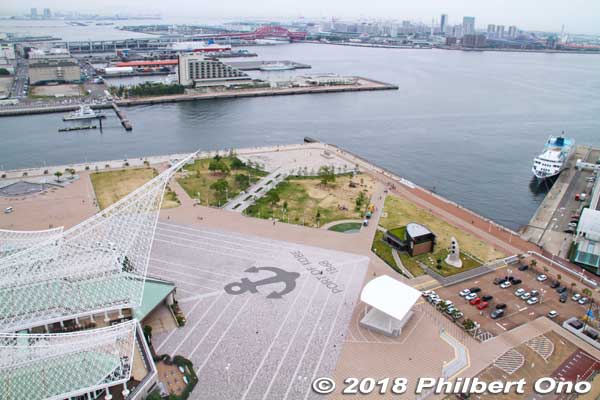
Kobe Port shore excursions on foot
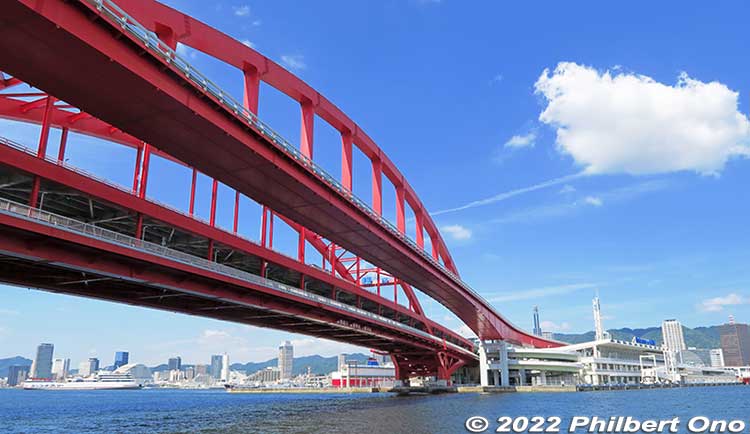
Kobe Port has a number of tourist attractions within walking distance from the cruise terminal. The Port Terminal Station is also right in front of the cruise ship dock. It’s also possible to walk from Kobe Port Terminal to Meriken Park.
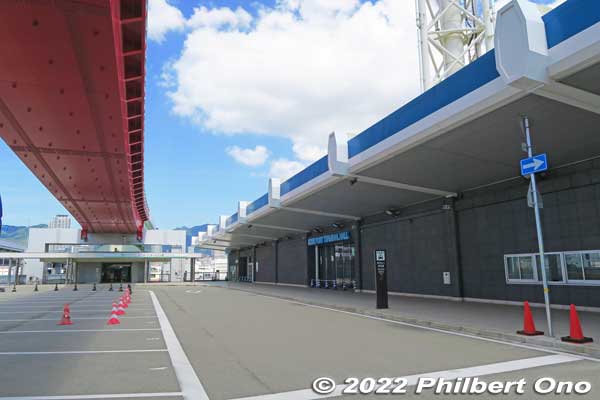
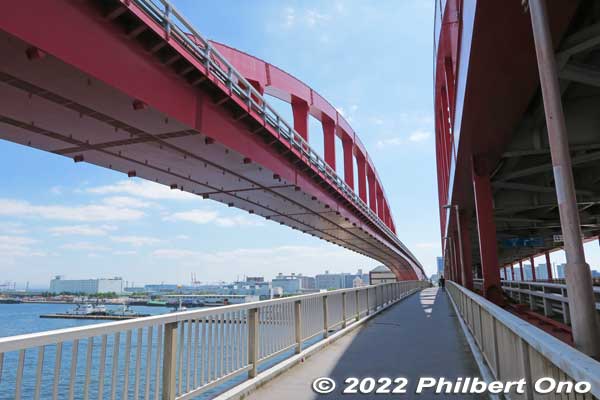

From Kobe Port Terminal:
- Port Terminal Station – Super convenient Port Liner train station right on the pier, right next to the cruise ship terminal. Goes to Sannomiya, Port Island, and Kobe Airport.
- Sannomiya – Major train station for JR, Hanshin, and Hankyu Lines. Many shops, arcades, and restaurants in the area. A few minutes from Port Terminal Station by Port Liner train. Also nearby is Ikuta Shrine, Kobe’s most famous Shinto shrine.
- If the sights near Kobe Port are not enough to impress you, then I strongly recommend going to Sannomiya Station and take the JR train (about 40 min. ride) to Himeji Station to see Himeji Castle.
- Kitano Ijinkan-gai – Western homes of early foreign settlers in Kobe’s former Foreign Settlement, one of Kobe’s major sights in Kitano, north of Sannomiya Station. An outdoor architectural museum.
- Kobe Ohashi Bridge – Built in 1970 while Port Island was being reclaimed, this red, double-decker highway bridge is connected to Kobe Port Terminal. It goes to Port Island. It also has a pedestrian walkway (322 meters long) on both sides giving fine views of Kobe Port Terminal, passing ships, and Meriken Park. In the evening, the bridge is lit up until 11:30 p.m. There’s also a parallel red bridge for the Port Liner train.
- Port Island Kita Park – On the other end of Kobe Ohashi Bridge, this small waterfront park also has a Western-style home called Kobe Minato Ijinkan (神戸みなと異人館). Originally built in 1906 by an American businessman. Moved here in 1981 for the Portopia ’81 Expo. Normally not open to the public.
- Port Island – Artificial island now occupied by hotels, universities, hospitals, and container ship berths. The UCC Coffee Museum might be interesting to visit. The island was the site of Portopia ’81, a highly successful exposition in 1981. Slightly beyond Port Island is Kobe Airport. Accessible by the Port Liner train.
From Nakatottei Pier (Naka Pier Cruise Terminal) (Meriken Park):
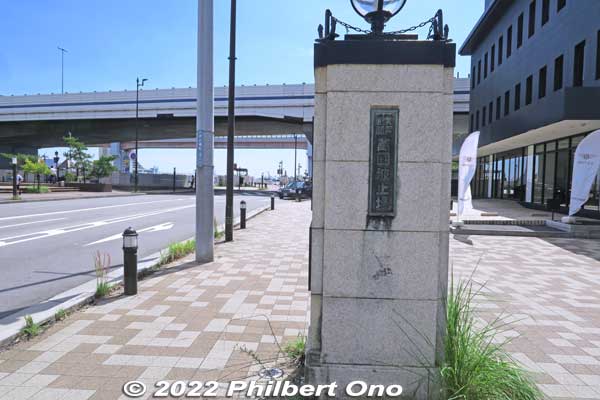
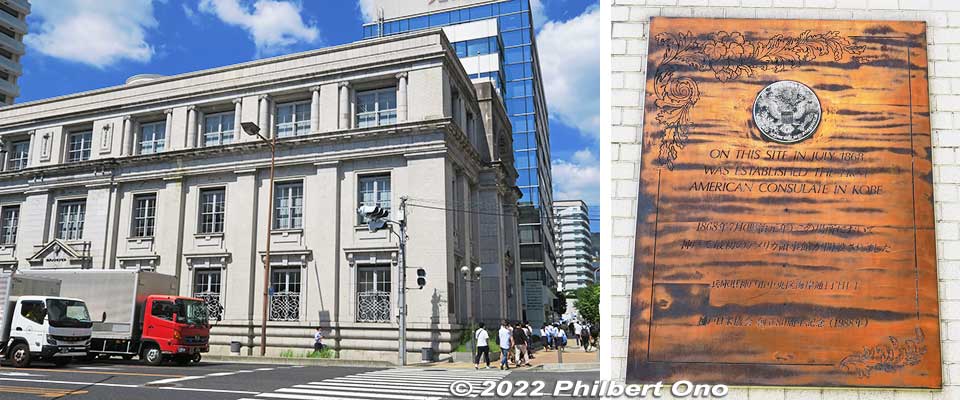
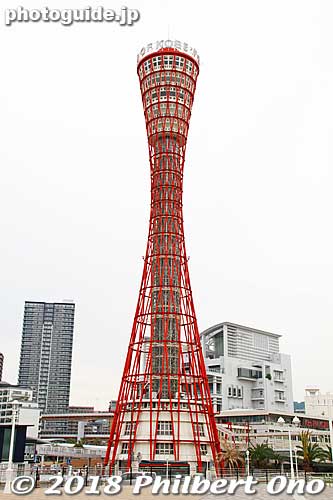
- Meriken Park – Reclaimed land turned into a waterfront park between the original Meriken Pier and Nakatottei Pier. Kobe Port Tower, Kobe Maritime Museum, and the Port of Kobe Earthquake Memorial Park. There’s also a sculpture and monument for Japanese emigrants to South America.
- Kobe Port Tower – Great views of Meriken Park, Nakatottei Pier, and Kobe. Built in 1963 as the symbol of Kobe Port standing 108 meters and shaped like a tsuzumi shoulder drum. The tower’s lower floors have gift shops and restaurants. Currently closed for major renovations and earthquake resistance. Will reopen in 2023.
- Kobe Customs International Pier Monument – Small monument marking the location of Kobe Customs building which was at the base of Meriken Pier, Kobe’s first pier. It’s also cross from the former location of the Kobe U.S. Consulate which gave the pier the nickname “Meriken” (misnomer for “American”).
- Kobe Chinatown (Nankin-machi) – Chinese restaurants and shops.
- Harborland – Waterfront shopping complex highlighted by a ferris wheel.
Also see: Yokohama Port | Tokyo Port | Hakodate Port
Port of Kobe: http://www.kobe-meriken.or.jp/en/
Cruise Port Guide (Kobe): https://www.mlit.go.jp/kankocho/cruise/detail/031/
Content Navigator
State of Japanese Cruise Industry in mid-2022
- COVID-19 not over yet
- International cruise ships in Japan
- Japan still closed to international cruising
- Essential Japanese Vocabulary
- Ship comparison
- Japanese cruise ship advantages
- COVID-19 protocols
- Basic cruise rules
- Safety Record
- FAQ
- Asuka II
- Nippon Maru
- Pacific Venus
Ports for Cruise Ships in Japan
- Cruise ship departure ports
- Japan’s popular ports of call
- Shore excursions
- Mega-ships and harbor bridges
- Japanese port history
- Port town songs
- Major Japanese Ports: Yokohama | Tokyo | Kobe (Current page) | Hakodate | Nagoya | Kanazawa | Toyama | Amami-Oshima Naze | Yakushima Miyanoura